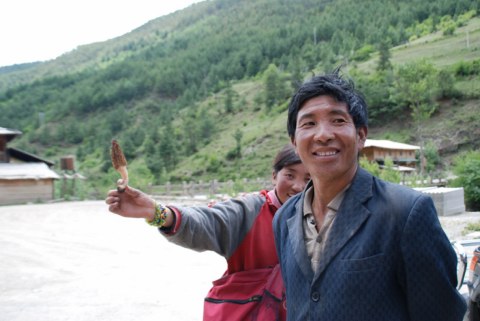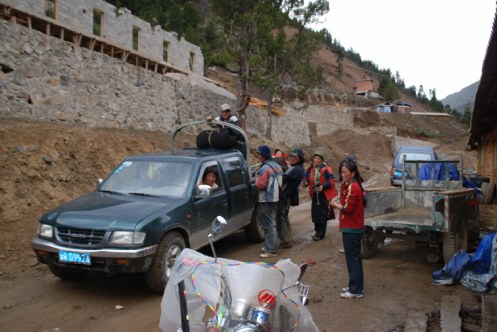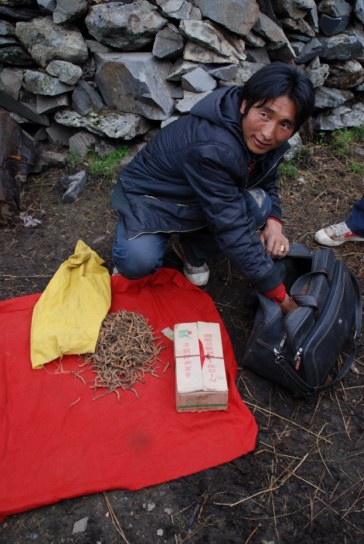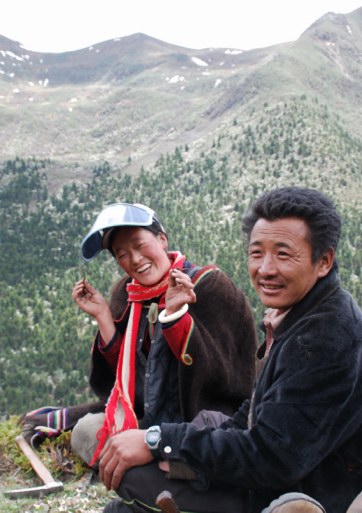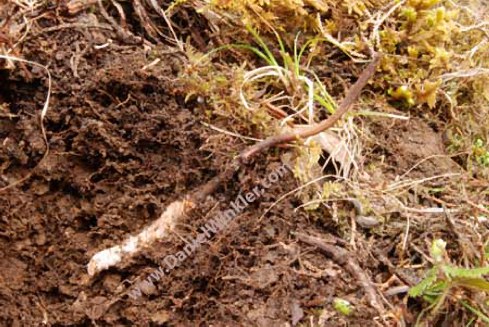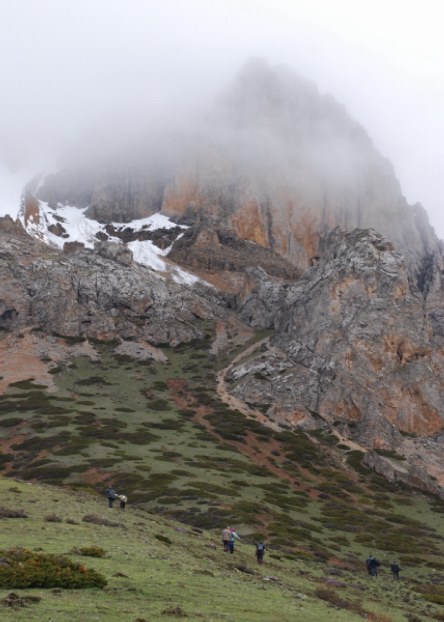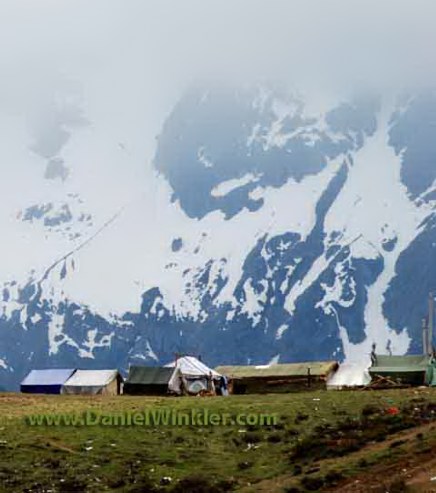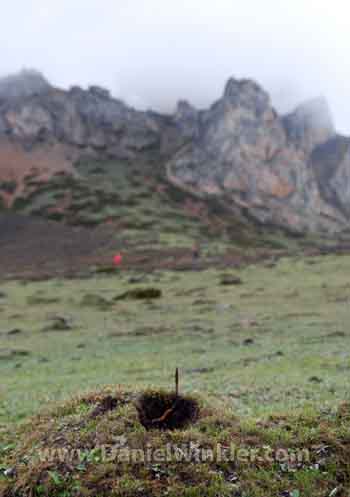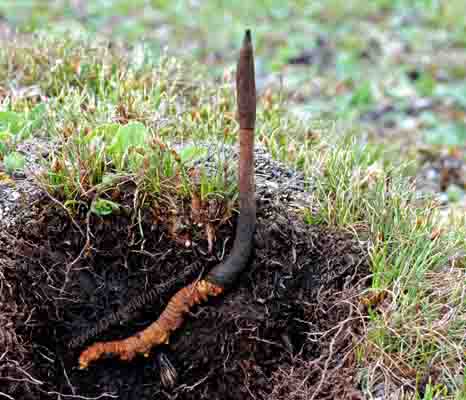Cordyceps & Morel Expedition to Tibet
Expert guided by Daniel Winkler 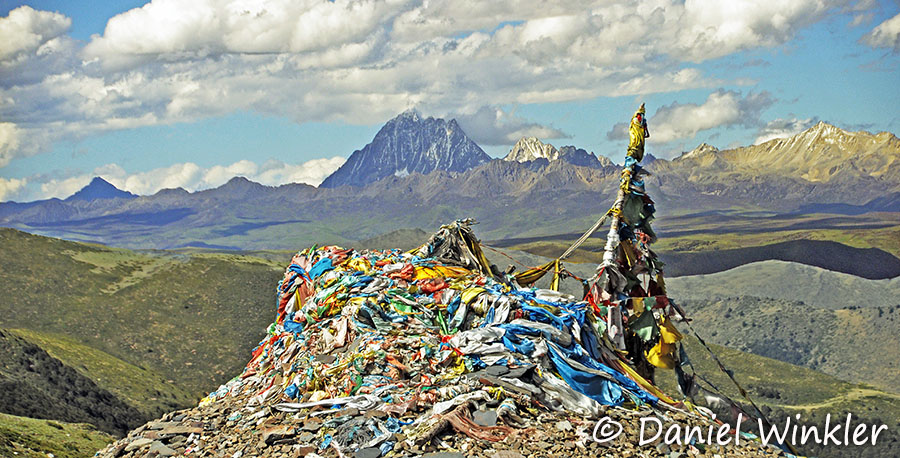
Mani stone cairn with Wind horse prayer flags. In the background alpine pasture habitat of Yartsa gunbu (Ophiocordyceps sinensis) below the towering peak of Mt Zhara Lhatse (5820m / 19,910ft). Looking East over Kangding County, Ganzi Tibetan Autonomous Prefecture, Sichuan. June 2015
2018 Cordyceps & Morel Expedition Announcement
May 27 to June 8, 2018 - Register now
Tracking Cordyceps sinensis, known in Tibetan as bu short for `yartsa gunbu' (summer grass, winter worm), is certain to be a once in a lifetime fungal, botanical and cultural experience among some of the most stunning landscapes on the planet. Simultaneously to the fruiting of Yartsa gunbu Tibetan morels are popping up in a variety of habitats on the Tibetan Plateau. We have successfully carried out six Cordyceps expedition tours since 2006.
Our goal is the tracking the elusive caterpillar fungus endemic to the Tibetan Plateau. In the last decade bu, as Tibetans refer to it, has developed into the main source of income for rural Tibetans. The expedition will start in Chengdu, the capital of Sichuan, where we visit the biggest medicinal herb and fungi market in China. West Sichuan has extensive Cordyceps sinensis habitat in the mountainous western half of the province, which is traditionally all Tibetan. During the collection season the lifestyle of Tibetans become completely consumed with the collection of yartsa gunbu; every able-bodied is out on the alpine pasture collecting yartsa in order to secure cash for the coming year. In prime collection areas as we will visit households who often derive 70-90% of their cash income from bu collection [Figures from Winkler 2008, Economic Botany 62.3]. In order to cater to this new industry supply shops and bars with pool tables spring up each spring on the grasslands. In the towns lively selling occurs followed by Tibetan buying sprees undertaken with newly made cash. On this journey we travel over high altitude grasslands, roamed by yaks. We will be visiting camps of bu collectors and nomads and join Tibetans in looking for the elusive fungus (see my Infested by the caterpillar fungus or my more recent piece published in Field Mycology). In the high altitude grasslands we might encounter snowfall but if so, it usually melts away in a day due to the intense subtropical sun. Once Spring is in full swing in the deep valleys, morels (Morchella spp. - new research shows that East Asian morels differ taxonomically from European or North American species, see Du, X., Zhao, Q., O'Donnell, K., Rooney, A.P., Yang, Z.L. 2012. Multigene molecular phylogenetics reveals true morels (Morchella) are especially species-rich in China. Fungal Genetics and Biology. 49(6):455-469) and other early fruiting mushrooms may be sprouting in the woods. In order to experience this, we will take our time and join Tibetan collectors to hunt for morels. However for the 2011 routing I am not as confident as in previous years to be able to guarantee morel finding, but we will try our best. One of the Tibetans names I came across in my research for the morel is "khukhu shamo", the cuckoo mushroom. This name allude to its fruiting season, which coincides with the return of the cuckoo, one of Tibet's best known birds due to its unique and loud call. In Riwoche in 2005, I was awoken by the "coo-koooo coo-koooo" calls from a cuckoo right outside of my room. Economically speaking morels are in the top-five economic mushrooms in Tibet (after Cordyceps and Tricholoma matsutake), because they are exported to Europe. Also, at this time the alpine flora is awakening and we will be treated to seemingly countless species of Primula, Iris, Incarvillea and peonies to name just a few, as well as an ocean of multicolored Rhododendron. There is also a strong cultural component to this journey. We will visit many Tibetan Buddhist and Bonpo monasteries, monuments and hermitages in incredible locations. We will experience the mysterious and colorful spirituality that lies at the heart of Tibet and its people and will have plenty of opportunities to learn about Tibetan Buddhism. We will do several day hikes, some of them on pathless steep slopes, thus you should be in fair to good shape. You do not need to be an athlete, but extreme shortness of breath is magnified in a high altitude environment. But we are all impacted by the high altitude and we will adjust excursion to our capacity. This is not a trekking adventure, rather we attempt to do "drive-in" mushroom hunting. The drive-in is a bare necessity in a place as vast as Tibet, but the roads cross plenty of open, wild spaces that after a 30 min walk one feels like in the middle of nowhere. If you are interested in taking part in this journey, please let us know as soon as possible. In order to maximize group interaction in all aspects of the journey we will limit the group size to 12 participants, but so far the dozen was never full.
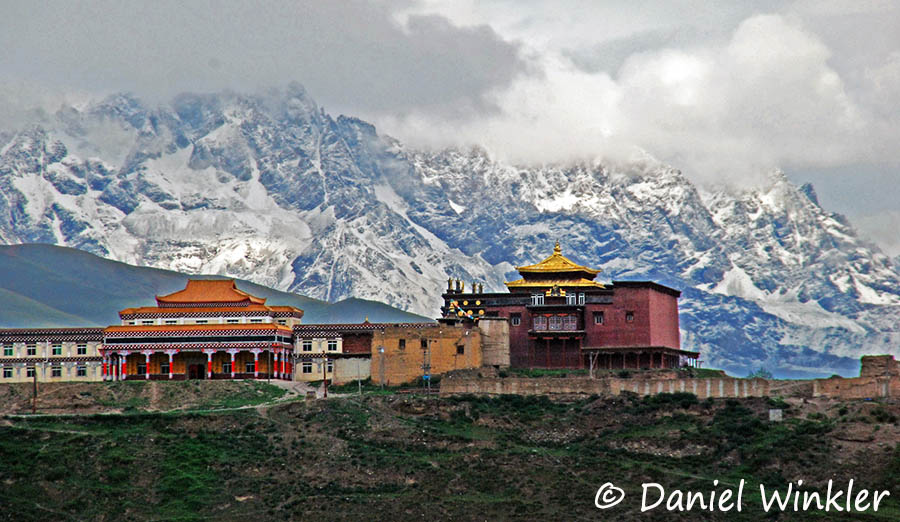
Beru Gonpa in front of the Ganzi Snow mountains, Ganzi county, Ganzi Tibetan Autonomous Prefecture, Sichuan, June 2012.© Daniel Winkler
 2018 East Tibet Cordyceps & Morel Expedition details 2018 East Tibet Cordyceps & Morel Expedition details
May 29 we are meeting in Chengdu, the capital of Sichuan Province. Chengdu is one of China's most interesting places with a long history. In the morning we will drive towards the mountains and will start to slowly ascend to the Tibetan Plateau via Kangding, where yartsa gunbu dealers will have flooded the street markets. Kangding, known to Tibetans as Dartsendo, is the traditional gateway to eastern Tibet and historically was the main market town between Tibet and China. Tibetans brought down by yak caravan medicinal herbs & fungi as well as horses and traded for tea, brocades and other Chinese commodities. Nowadays, Kangding, meaning the suppressor of Kham in Chinese, is also the capital of Kandze/Ganzi Tibetan Autonomous Prefecture.
From Dartsendo we will drive up the Gye La Pass (Zheduo Shankou, 4290m) the threshold to the Tibetan Plateau, where the landscape widens and the air becomes thin and clear and Cordyceps is growing. Up here we will visit the famous Lhagang Monastery(= Tagong), where typical Tibetan temple architecture is blended with Chinese architectural elements. In the background is the famous Zhara Lhatse (= Yala Shan, 5820m / 19,095 ft). The next two nights we will spend again in a bit lower elevation in Dranggo (Luhuo), one of the more fertile areas of Kham, as this hole region is known to Tibetans. We will have a whole day in Dranggo to check out the town and to hunt morels, which are growing in spruce-fir forests in the mountains. The tour is timed to hit peak morel season, but only on site will we find out if we are lucky enough. In our next stop Kandze (=Garze = Ganzi), we will staying for three nights in a nice Tibetan run and owned hotel that even offers wireless. We will be exploring the surroundings of Kandze, which abounds in monasteries, villages, hot springs and snow covered mountains. We will visit a Tibetan farm house and with some luck enjoy a meal of traditionally fried Karsha (horse mushrooms). Also on June 1st is Children's day and we hope to join an outdoor celebration complete with dances and picnic and when lucky a horse race. Another day will be dedicated to do a short hike into Cordyceps habitat with our Tibetan guide, his family and friends. Besides Caterpillar fungus we also will find some Fritillaries, Primulas, Iris and Rhododendrons in flower. Back down we should be ready for a nice soak in Rongpatsa hot spring, a beautiful open air spring with most stunning mountain views.  After Kandze we will move South along the Nyachu (Yalong) River gorge to Nyarong (Xinlong). On the way we pass the glaciated sacred Kawalori , seat of a powerful mountain deity. Nyarong is famous for its lamas, yogis and formerly for its warriors. Not far from Nyarong town, on the slopes of the sacred Norbu Yangtse peak we can observe wild blue sheep, ptarmigans and with much luck musk deer above Kalzang Gonpa. This area is the birth place of Nyala Pema Dudul, a famous lama, who in 1872 realized rainbow body, the highest realization in the Dzogchen tradition. Also the last documented case of realization of rainbow body was realized by Khenpo Achos at Nyarong in September 1998 .
Then we will continue towards Litang, supposedly the highest "city" in the world at 4013m (12,500ft). On the way we will cross some excellent Yartsa gunbu habitat and try our luck in finding some. Litang is a center for Yartsa gunbu collection and there is a long tradition of its trade and we will visit the caterpillar fungus market. Litang is also a center of Tibetan culture, home to Litang Chöde Gonpa founded by the 3rd Dalai Lama in 1580. Litang is also the birth place of Sonam Gyatso, of the 7th Dalai Lama and we can visit his former home. We will stay in the comfy Potala Guest House, a Tibetan owned and run house, whose wireless internet and the option of enjoying a coffee or hot chocolate with a pancake easily off sets the simplicity of the rooms.
From Lithang we will drive 2 hours South along seemingly endless high altitude pastures dotted with impressive giant granite rocks and dotted with nomad tents towards Drabba (Yalong Xian), where there is a new airport built onto this landscape, which allows us fly to Chengdu in an hour versus driving two days. When lucky and getting window seats we might have a spectacular view of Minya Gongkar (Gongga Shan, 7590m / 24,783ft), the highest mountain outside the Himalaya-Hindukush range. Once landing in the red basin of Sichuan, the bustling city of Chengdu awaits, probably under the humid layer of low clouds. In the afternoon we will visit China's biggest materia medica markets, probably the world biggest market for herbal, fungal, animal and mineral medicinal raw material. Already here we will see plenty of caterpillar fungus including some other Cordyceps species from the lowlands. This last night we will have a special good-bye banquet with Cordyceps militaris dishes enjoying the comforts of a big city.
 | Day # | Date |  2017 Itinerary - Cordyceps Expedition 2017 Itinerary - Cordyceps Expedition exploring Eastern Tibet - West Sichuan |  | 1 Sunday | May 27 | Chengdu - Kangding / Dartsendo |  |  | 2 | May 28 | Kangding - Tagong / Lhagang Gompa - Luhuo / Dranggo |  | 3 | May 29 | Luhuo: morel hunt |  | 4 | May 30 | Luhuo - Khasa Lake - Ganzi |  | 5 | May 30 | Ganzi - Rongpatsa - Hike - Ganzi |  | 6 | June 1 | Ganzi: hike with Cordyceps hunt |  | 7 | June 2 | Ganzi - Kawalori - Nyarong / Xinlong |  | 8 | June 3 | Nyarong: Kalzang Gompa on Sacred Mountain |  | 9 | June 4 | Nyarong - Chungba / Junba - Cordyceps hunt - Lithang |  | 10 | June 5 | Lithang: Cordyceps market, visit monastery and hot springs |  | 11 | June 6 | Lithang - Daocheng |  | 12 | June 7 | Daocheng - Chengdu by plane |  | 13 Friday | June 8 | Chengdu: the fungal fellowship disperses |
 Please note, that our itinerary is purposely kept flexible in order to insure that we search for bu in the best possible alpine grasslands, which will be hard to pinpoint until we are actually on site. Rest assured that all places we journey are stunningly beautiful. Since we will be traversing a wide range of altitudinal zones we have an excellent opportunity to catch the peak Cordyceps fruiting season wherever it occurs. We will travel from warm subtropical Chengdu basin in 500 m (1600 ft), to cold temperate and alpine areas up to 4600 m (14,000 ft), thereby experiencing a wide range of ecosystems, all with their unique flora, fauna and funga.  Cordyceps Expedition Cordyceps ExpeditionMay 27 to June 8, 2018 Land Costs: $3,950 Price for 10 to 12 participants,
[with 7-9 participants $4200, 4-6 participants: $4450] includes all accommodation, food, overland transport Single room supplement: $450 Additional costs: flight to China: $800 -$1200
ticket needs to be purchased individually by participant flight from Daocheng to Chengdu, $100 to $200 ticket will be purchased by our agent in Chengdu Other expenses: Souvenirs, alcoholic beverages, hotel bar, phone & laundry, tips for Tibetan guides. Last possible registration date: Nov. 9, 2017 Note that travel in the Tibetan areas is quite strenuous. All the walking is in high altitude, thus you need to be comfortable walking. Hunting for mushrooms can include walking up steep slopes with no trails for short distances. We are not running up mountains, since the altitude slows us down considerably. On several days we travel several hundred miles in our SUVs, some parts of the roads can be under construction.
Last revision Aug 26, 2017 |
Cordyceps dealers on Lithang's main street, Kandze TAP, Sichuan. © Daniel Winkler, June 1999, Litang County. |
Registration If you are interested in taking part in this journey, please let us know as soon as possible. In order to maximize group interaction in all aspects of the journey we will limit the group size to 14 participants. Feel free to share this info with your friends. Be sure to check my photo trip reports from previous years (2010, 2009) and photo essay section of my website where you can see a lot of Tibetan mushrooming related pictures (as well as flowers, wildlife, people, culture etc.) Sacred Drokar Mountain with Lhanglhang Norbu monastery and Yangtze Villlage in Nyarong, Ganzi TAP, Sichuan Well, when the forest is growing up to 15.000 feet they apparently reach into the rainbows. Nyachuka County / Yajiang Xian, June 2012 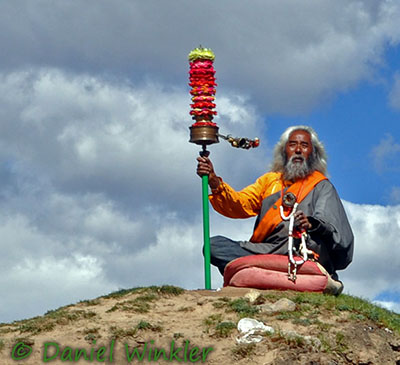
A Yogi with his prayer wheel. Near Beri Gonpa, Ganzi, May 2015
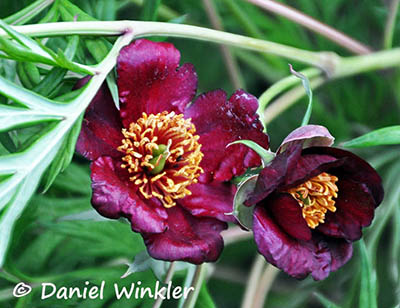
Delavayi's peony (Paeonia delavayii) near Kawalori Gonpa, June 2015
| 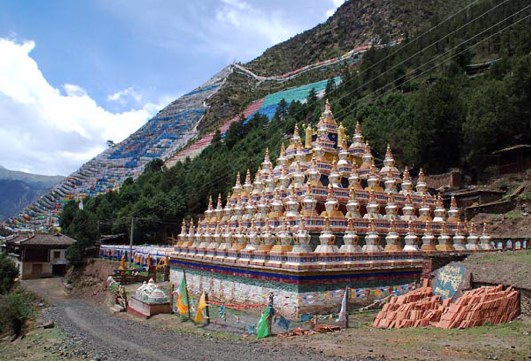 Stupa decorated with colorful photo-tiles at the foot of the sacred Kawalori Mountain in northern Nyarong. In the background rows upon rows of prayer flags. Nyarong / Xinlong County, Ganzi TAP, Sichuan. Stupa decorated with colorful photo-tiles at the foot of the sacred Kawalori Mountain in northern Nyarong. In the background rows upon rows of prayer flags. Nyarong / Xinlong County, Ganzi TAP, Sichuan.
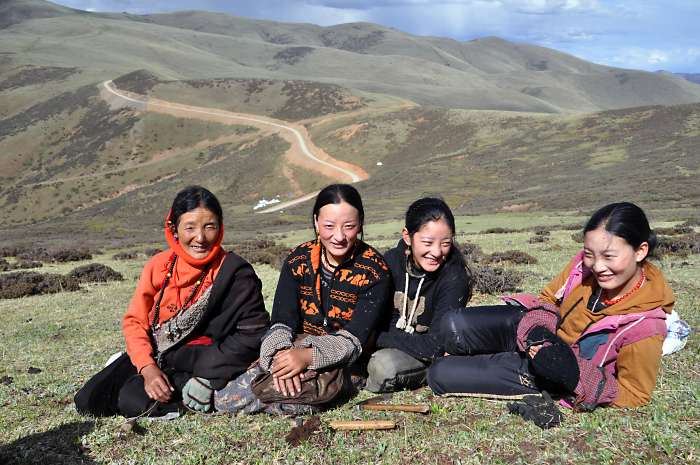
Chodron with daughters Lhamo, 25 years, Lhaden, 17, and Chintso 20. They are coming every year for Yartsa gunbu collection from their home town near Lhagang to Lithang, June 2012. 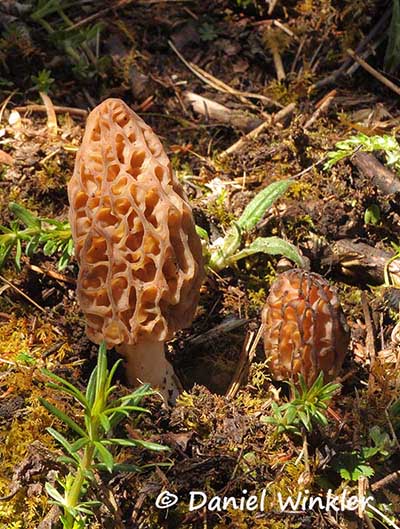
Khukhu Shamo, meaning Cuckoo Mushroom, as Tibetans know morels (Morchella spp.) since they grow at the same time as the famous cuckoo bird returns from India. We find them in the subalpine spruce-fir forests in early June. Dranggo County / Luhuo Xian, May 2015.
| -  Photos from the 2009 Cordyceps Expedition to SE Nagchu Prefecture Tibet AR Photos from the 2009 Cordyceps Expedition to SE Nagchu Prefecture Tibet AR A Tibetan collector scans the ground to find the brownish fruiting body of a caterpillar fungus. Because the fruiting body is not yet mature early in the season the search is extremely difficult. At this point the visible, above ground portion, was not more than 1.5 cm long.
All photos: Daniel Winkler, location and date if not mentioned: Nagchu County, Tibet AR, late May 2009. | -
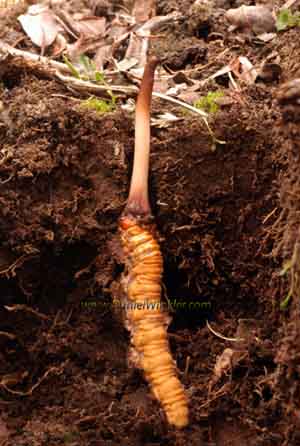 A partially excavated, exposed and cleaned specimen of Yartsa gunbu. May 29, 2009, Nagchu County. |
Namtso with the Nyenchen Thangla Range. July 11, 2010 | 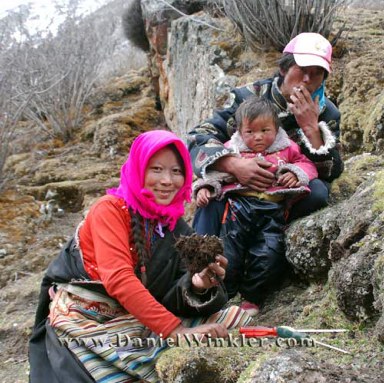
Yartsa gunbu digging in Tibet generates real "family value". | Families collecting Yartsa gunbu search a steep slope still dusted with the remnants of a snowstorm from the previous day. According to some collectors 20 to 70 Yartsa gunbu, even up to 100 a day, can be found here! This is 5 to 10 times higher than the typical personal yield on a poor site. However, our joy having found these rich Bu grounds was short-lived. Although we had valid permits to be in Driru issued by the permit office in Lhasa, the local authorities told us, "no foreigners are allowed in SE Nagchu Prefecture during Yartsa gunbu season this year. Your permits are worthless, we'll fine you". So we had to relocate to a new study site. Above Tsa Chu Hot springs north of Chaktse in 4300 m, Driru County / Biru Xian, Nagchu / Naqu Prefecture Tibet AR.
Tibet in the 21st Century. Insulated tents for the yartsa gunbu collectors pitched under a cell phone tower at 4350 m altitude along the brand new "Ragdi highway". We were told the highway is nick-named for the TAR leader who built this excellent road in his remote home county to show off his power. However, getting to that beautiful stretch of paved road one has to travel on extremely bad dirt sections of the northern branch of the Sichuan-Tibet Highway, which has much more traffic and for many years has needed improvement but is just decaying. Biru County May 26, 2009.
Parked motorcycles in the middle of nowhere on the base of a slope are a clear indication that there are Bu fields above on the slopes. Driru County, May 27, 2009
A collectors camp pitched in the background. In the foreground motorcycles and a micro-van. Many mobile fungus dealers use these entry-class vehicles. It is incredible what kind of bad roads these small cars can navigate. Nagchu County, July 18, 2009
Just a few hundred meters form the collectors camp.... Eurasian Griffon Vulture (Gyps fulvus) feasting on a the left overs of a yak. Not much is left to scavenge for the Griffon vultures. They had to wait until the Bearded vultures had their fill. | Bu dealers showing their goods in a "green" Tibetan restaurant in Nagchu Town. "Green" means, as we were explained, no smoking and all vegetarian food.
It turns out 2009 was a very bad year for Yartsa gunbu collection. Although the season started out wet in some areas like Nagchu, the spring rains were very weak and the summer monsoon came extremely late. Thus, there were not many Bu to find and many of them had poor or strange growth like these two specimen - see enlargement below. They were found July 18. Usually the season is over much earlier, but the fungus was still "hanging on" in hope of some rain to provide moisture to be able to grow its fruiting body [=stroma] to finally produce some spores.
Close up of picture above. Looking closely at the tops of the stromata of these two Bu, one has a split open, broken off stroma, the stroma of the other Bu is also deformed. It looks as if there were five growth spurts that had to be terminated immaturely due to lack of sufficient moisture. |

| | | A bu digger using a simple wooden instrument. Digging Cordyceps one has to be very careful not to break the fruiting body from the caterpillar. While larva and mushroom are quite tough, the point where the mushroom grows out of the head is fragile. © Daniel Winkler, Serkyim La, 2006 |
Cordyceps sinensis fruiting body with well developed asci cells. The top seems to have been gnawed off by some small creature. © Daniel Winkler, Kongpo Barla, June 2006 | Fungal candy anyone? Tibetan lady offeringCordyceps for sale in a candy bag on the way to Kongpo Barla Pass. June 2006 © Daniel Winkler. If you would like to use any of my photos, please contact me by email: |

Notes on Accommodations, Food & Weather and Altitude (I replied to questions by the New York Times "Practical Traveler" Michelle Higgins)
Michelle: What is the weather like at this time in the region you're going to? Daniel: Right now in late April, peach, apple and wild cherry trees are flowering in the warm valleys of Central Tibet. The temperatures in Lhasa are much milder than people imagine. In summer it correlates quite well to Seattle, my hometown since 13 years. It rarely goes beyond the low 80s during the day, but cools down nicely at night to the high 50s. Winters are bone dry and sunny, mid June thru September is summer monsoon, the rainy season. The Monsoon is not comparable in its strength to the Himalayas like in Nepal or Bhutan. It rains often during the night or there are thunderstorms in the afternoon, but clouds come and go. It is said, that some fungophiles, when it is raining, actually perceive mushrooms falling from the sky. The weather is different where we are looking for caterpillar fungus, since we are up in 12'000 to 16'000 ft. Although it is mostly sunny, it gets quickly cold without the sun and often there is wind. Weather changes can happen fast up there. If there is precipitation in late May and June it is often sleet, hail or snow. But everything melts quickly away, the sun is extremely powerful due to the thin air and Tibet's subtropical location; Lhasa for example is further South than any place in the lower 48s.
Was 2008 the first tourism-oriented mushroom tour you offered? I have been tour guiding for other companies like High Asia Expeditions [since 1997] and Betchart Expeditions [since 2005]. But my first self-organized MushRoaming tour was in 2006 to Tibet. In 2007 I organized one tour to Tibet and one to Europe's around the International Medicinal Mushroom Conference in Slovenia. In 2008 we went to the Tibetan areas of Northwest Yunnan for the Cordyceps Tour.
Do you know of any other tour operators that are offering mushroom tours or some kind of food-related, culture excursions to Tibet? I don't think there is anyone offering anything like that to Tibet or the Himalayas. There is Buddhist pilgrimages for western Dharma students, there are some other Botanical tours and tours for birders. I also guide botanical tours and the summer foray is a fungal and floral foray. There is no one I am aware of who does culinary tours. Partially that could be because Tibetan cuisine is not regarded as one of the great cuisines, although there are great dishes and interesting specialties to discover. Nowadays, most restaurants are Chinese-run in Tibet. There are also many Muslim noodle shops, a safe stop in really remote places. These Tibetan "fast food" places are run by Hui, Chinese Muslims, usually recent immigrants from Gansu. I always love to introduce people to Tibetan dishes in Lhasa and try to find Tibetan restaurants in other towns too. Tourism has surely helped to drive this development. Besides the typical dishes such a as Thukpa, a Tibetan minestrone or Momos, basically a Tibetan version of ravioli, noodles stuffed with minced yak or other meats with onion, shallots or garlic. The culinary most popular mushroom in Lhasa is Sersha, the Golden mushroom (Floccularia luteovirens), a beautiful, scaly, bright yellow Portobello-like agaric, which grows on the grasslands in summer, sometimes around also edible field mushrooms (Agaricus campestris), but we have to special order them or bring them ourselves from a foray. My favorite Tibetan desert is Troma, tiny silverweed tubers [Potentilla anserina] with a sweet potato taste served in sweet melted butter or better with fresh yak yogurt. These silverweed tubers are also eaten by native coastal people in Alaska I learned recently. And one of my favorites at the Snow Lion Restaurant is their yak steak with fried potatoes and a mushroom-wine sauce. You should see how much Westerners who finally made it to Lhasa after weeks or months in China appreciate the Tibetan food including the Indian and Western influence imported from Nepal. Also, in Nyingchi Town (Chinese: Bayi) there is a government shop for locally produced specialties and crafts. It sells dozens of mushroom varieties. An attached restaurant will cook them up for you and one can enjoy famous or obscure edible mushrooms one never tasted before. That is a very special treat.
The 2009 itinerary lists guest houses and few hotels as accommodations. What are these accommodations like? Do you have web sites for any of the places you can send me? In Lhasa we stay at the Kyichu Hotel. It is Tibetan owned and managed, they have really friendly people, a great restaurant where you can eat in the green back yard, fast internet, great service and clean modern bathrooms, you name it. Kyichu means "happy river", the name of the river running through Lhasa, now reduced to a new Chinese name, Lhasa He, simply Lhasa River. In general hotels are quite nice in bigger places, everything clean and even English speaking employees. In other places English will not get you too far. Also in the real back country some guest houses are probably better treated as an experience to talk about for the rest of your life. But you can bet that this is the best place in town, otherwise we would not use it. But we really try to minimize such experiences and do not guarantee them! Usually the standards have quite improved in Tibet and there is always washed sheets and boiled water.
The Cordyceps expedition leads us through some high country, since caterpillar fungus habitat is around treeline. However, we will not travel right away that high up. The first stage after Chengdu is Dartsedo / Kangding at 2600m (8530 ft), which gives us some time to adjust. Also, it is quite different if one is driving through high altitude country and going for a stroll or seriously hiking. Some easier hiking might occur on a later stage of our journey, but we will adjust our activities to everyone's capacity and if necessary also split up for an activity.
Altitude usually slows down everyone considerably in the first days. But since one knows what the cause for the lack of breath is, one can handle it fine and structure the activities according to it. And with every day passing it gets less of an issue. The first 2-3 days we take everything quite slowly, just check out local markets or drive up to sites, temples etc. One easy fundamental is drinking a lot of water. We always provide bottled water for everyone. We also have access to bottled oxygen. Our Tibetan counterparts always have it on the bus or in the car. And a couple days later, we are still not climbing mountains. When we are out in nature we use more of a drive-in approach, since the roads cut through very beautiful country. We take plenty of time to stroll and explore. Yes, we might go up slopes, there are plenty of those, but if so very slowly. We all pretend it is not the altitude, but just the plants, insects, mushrooms and taking pictures that slow us down. Our hotels are mostly in towns in the lower valleys, but not every night.
Of course if you had serious high altitude problems before, it is not a good idea partaking in this tour. However, having had some discomfort before in high altitude is natural, I still go through that, but it passes and I don't worry too much, since I know what is going on and it will subside.
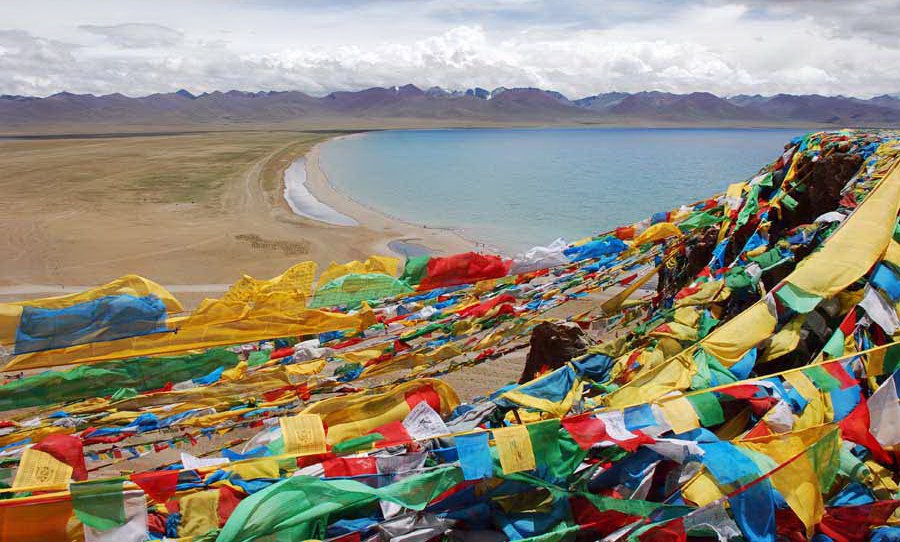
The sacred Namtso Lake with the western slope of the glaciated peaks of the Nyenchen Tangla Range with prayer flags adorning Tashi Peninsula.Nam Tso's surface is located in 4718 m / 15,475 ft) altitude. Nam Tso, which means "heaven lake" is the highest big salt water lake in the world. D.Winkler July 11, 2010
 Photos from the Cordyceps & Morel Expedition 2008 Photos from the Cordyceps & Morel Expedition 2008 to Dechen Tibetan Autonomous Prefecture - Yunnan Province
30-May Fri Gyalthang - Wang Shor Drive on the Gyalthang - Chatreng (Xiangcheng, Sichuan) Highway to Birong Gorge. Crossing of extensive clear cuts. Afternoon excursion to Namri Butong and short hike on mountain meadows in 4100 m, (12,700 ft) where locals collect Yartsa Gunbu, Cordyceps sinensis - caterpillar fungus. On the way up we meet Losang Yangzom and her group of morel pickers.
Morel pickers cooking tea after a long day of morel hunt. 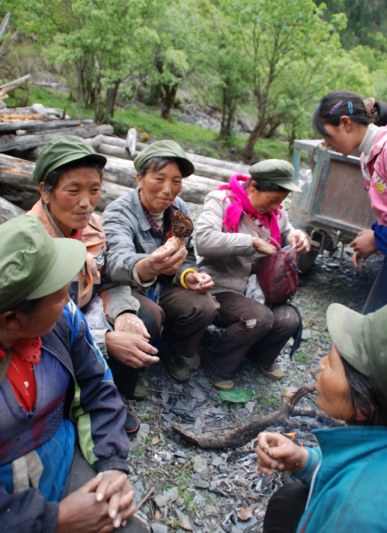 Losang Yangzom holding up a morel while taking a break before heading home after a day of morel picking. Losang Yangzom holding up a morel while taking a break before heading home after a day of morel picking. | A mushroom collector shows a fresh morel while hiding from the camera.
Bu hunters loading their tents. For them the season is over. In the back construction for a copper mine. Across the ridge is Pulong Copper mine, supposedly the biggest in China with an investment volume of ¥4.4 billion(US$ 640 million). The valleys drain into the gorgeous Birong Valley, which is renowned for its incredible biodiversity.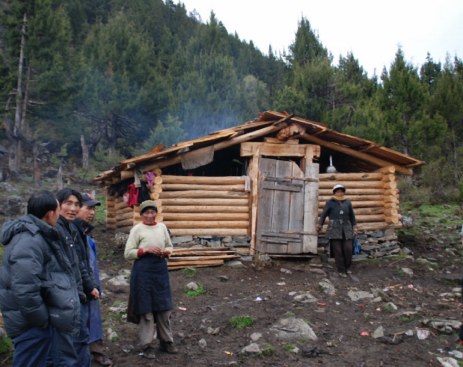 A hut recently build to accommodate collectors during the season. Night frost are common, and snow shower occur frequently. |
A bu dealer showing us the caterpillar fungi he had bought up. He drives to the remote collection areas and buys directly from collectors. |
|
31-May Sat Wang Shor - Namri Butong Yartsa Gunbu hunt (4000 m-4300 m, 12,400-13,300 ft) with Tendzin in Namri Butong. Bu found in open subalpine Rhododendron-Juniper forest on the South slope in 4200m (13,000 ft). Picnic with Tendzin and Wangmo on alpine pasture in 4300 m (13,300 ft). Afternoon morel hunt with Tashi Wangden (23) & Kelsang Dhondrub (21) from Wang Shor in 3750 m (11,625 ft) in degraded willow-evergreen oak forest on the South slope. All morels found under willows. Flowers: May apple - Podophyllum hexandrum, Primula amethystina var. brevifolia (on the pastures), yellow Himalayan poppy: Meconopsis integrifolia,Omphallogramma vincaefolia (Primula-like), tall Iris bulleyana (40 cm, 16"). Guesthouse -
 Wangmo with two yartsa gunbu - Caterpillar fungus. She is sporting a motorcycle visor, the dernier cri in Eastern Tibet these days. Her husband Tsering on the right and on the left a typical bu digging hoe. Wangmo with two yartsa gunbu - Caterpillar fungus. She is sporting a motorcycle visor, the dernier cri in Eastern Tibet these days. Her husband Tsering on the right and on the left a typical bu digging hoe. | A subalpine Fir-juniper forest with tall Rhododendron in flower. In a open juniper forests location we found a few yartsa gunbu to my surprise. So far I always found them in more open habitats, but apparently there were enough understory sedges and forbs to sustain Thitarodes larvae on which Cordyceps sinensisparasitizes.
A yartsa gunbu in situ. Some of the mycelium is visible growing around the larva. It is always peeled off before drying.
|
|
6-Jun Fri Namkha Tashi - Gyalthang Drive up to Pema Karpo / Baima Xueshan Pass. Yartsa Gunbu Search up to 4300m (13,300ft). Visit of the Cordyceps-collectors camp at the eastern end of the pass. Bu shopping. Picnic below the pass. Return Shangrila = Gyalthang. Gyalthang farewell dinner at Arro Khampa. Gyalthang Dzong Hotel A group of caterpillar fungus collectors on their way to remote hunting grounds.
A caterpillar fungus collector camp above treeline. In the background Pema Karpo. © Daniel Winkler, June 3, 2008, Dechen TAP, Yunnan |
A yartsa gunbu (Cordyceps sinensis) in its alpine habitat in the Tibetan areas of Northwest Yunnan. © Daniel Winkler, June 6, 2008, Dechen TAP, Yunnan
A caterpillar fungus half dug out in its typical habitat. © Daniel Winkler, June 6, 2008, Dechen TAP, Yunnan
If you would like to use any of my photos please contact me by email.
|
|



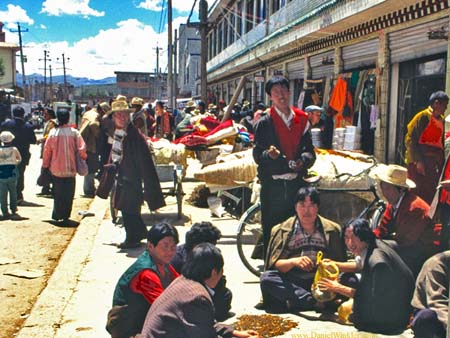
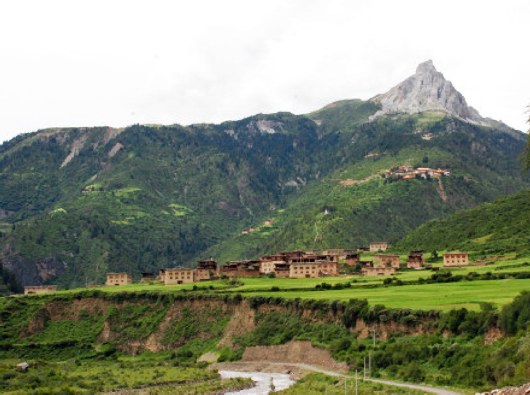
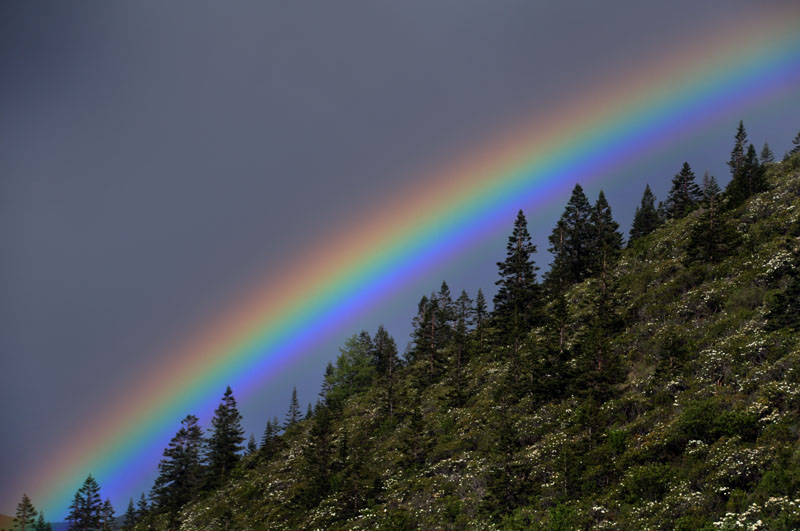




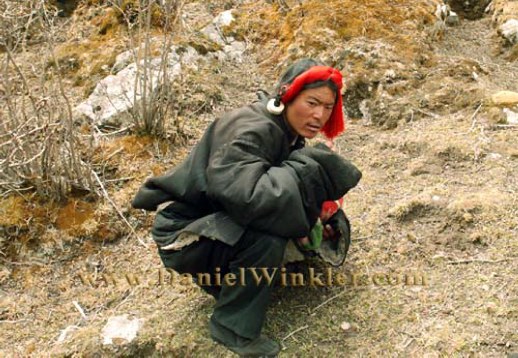

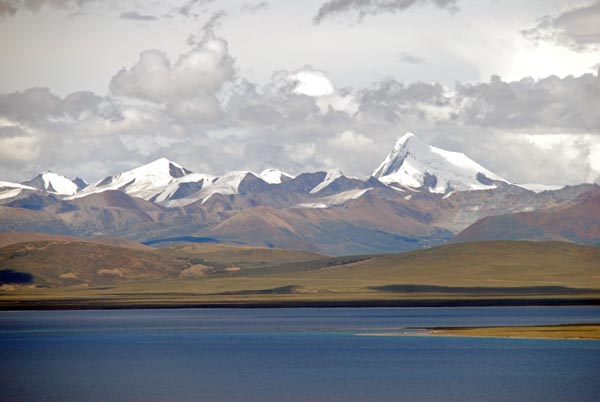

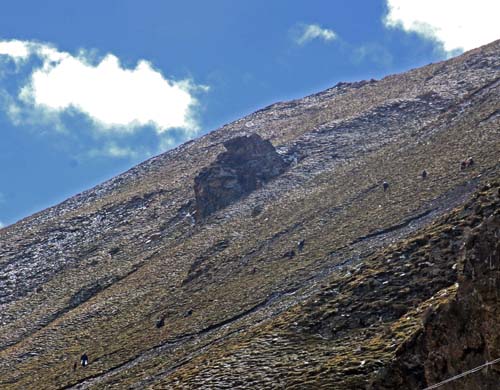
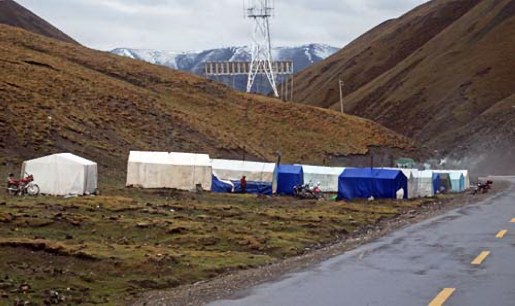
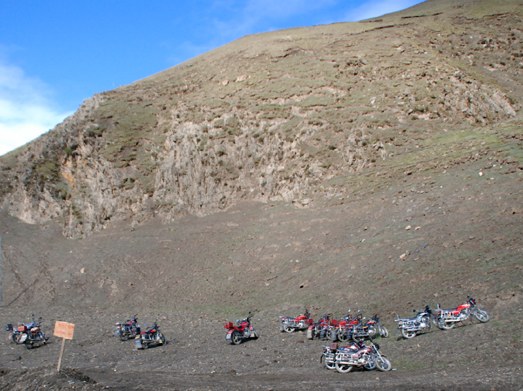
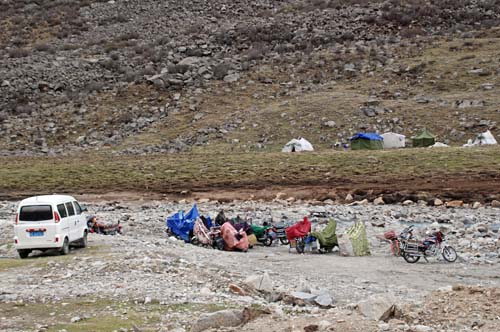
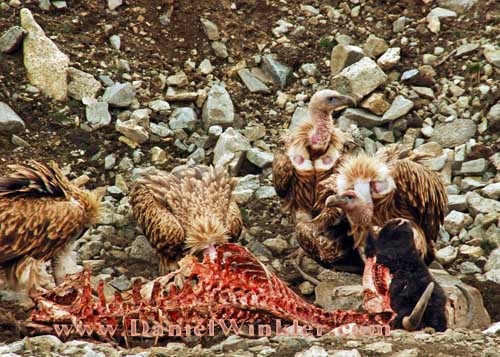
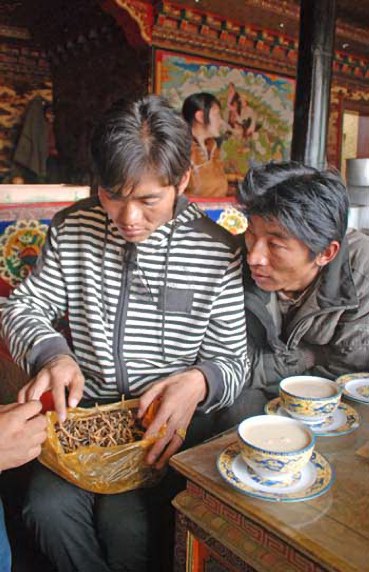
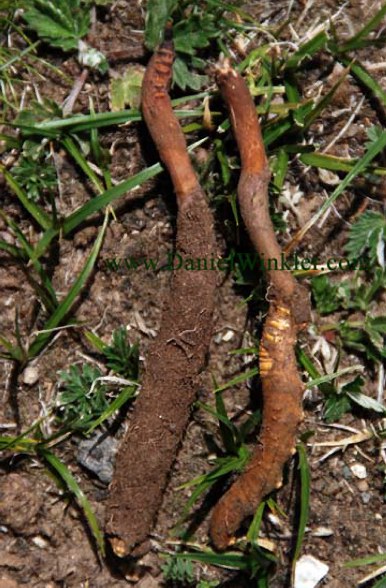
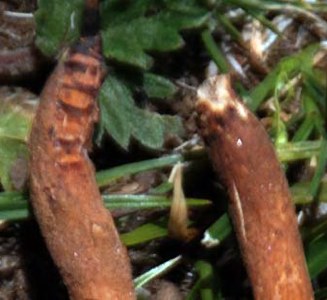

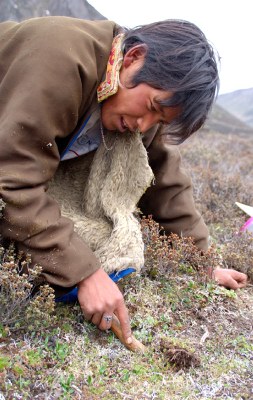
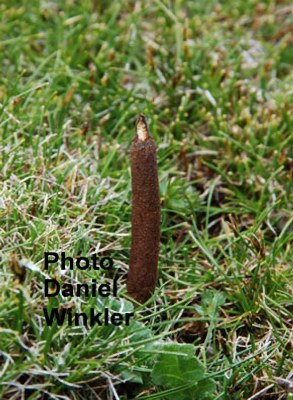
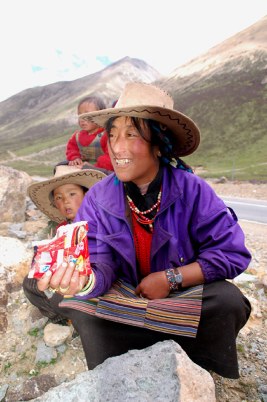

 Losang Yangzom holding up a morel while taking a break before heading home after a day of morel picking.
Losang Yangzom holding up a morel while taking a break before heading home after a day of morel picking.